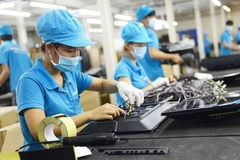With severe flooding in Thailand causing a spike in rice futures, concerns aregrowing over another food crisis.
Iwan J. Azis, Head of the Asian Development Bank’s Office of Regional EconomicIntegration, argues that with the increasing frequency of extreme weather eventslike the Thai floods, and the financialization of commodities, high food pricesare now the "New Normal", with profound effects on Asia and the world.
While there are no easy solutions, Mr. Azis offers a number of policyprescriptions in the following op-ed:
Catastrophic flooding and crop losses in Thailand, the world's leading riceexporter, are raising concerns that another food crisis may be in the offing.Further disquieting is the possibility that the world may have already entered anew era where persistently high food prices are the “New Normal.”
At a time when policymakers are grappling with a host of thorny economic issues,the possibility may be unwelcome, but must not be ignored.
Although volatility in commodity markets is nothing new, there are worryingsigns that food price fluctuations are now taking place within a much higherband-with than ever before. Even when prices dip they remain high by historicstandards, and when prices rise it’s enough to put a serious dent in families’budgets.
For Asia’s poor, who already spend 60% of their household budget on food, eventhe smallest fluctuation in food prices forces unenviable choices on where bestto devote their scant resources. More money for food means less for health care,education, or other important expenditures. It also means that those striving toescape poverty are less likely to do so, while millions more risk falling belowthe $1.25 a day poverty line.
The Asian Development Bank estimates that a 10% rise in domestic food prices indeveloping Asia threatens to push an additional 64 million people in to poverty.With food price inflation in many emerging Asian economies averaging 11% percentin the first half of 2011 alone, the growing numbers of families facing thescourge of dire poverty is staggering.
Much of the sharp increase in the region’s food prices is due to productionshortfalls caused by extreme weather events—such as droughts and floods—andsubsequent export bans by some food producing countries. Growing appetites forgrains, oil, seeds, sugar, and livestock in emerging economies like the People’sRepublic of China and India are exerting further upward pressure on supply.
There has also been a growing trend over the past decade to “financialize”commodities, turning food into an important tradable asset class, just likestocks, bonds, currencies, or real estate. As a result, movement in one majorasset—say, real estate prices in the United States—can drive food prices inother parts of the world to levels well above what real supply and demand mightdictate. The current super-easy money policy in industrial countries may havealso driven the financialization of commodities.
And then of course there’s the weakness of the US dollar, in which most foodcommodities are denominated, as well as high oil prices, which raise costs atalmost every step of the food supply chain, from fertilizer and animal feed, tofuel for bringing food from the farm to kitchen table.
With a “New Normal” of persistently high and volatile food prices here to stay,what are policymakers to do?
There are no easy solutions, but when faced with bouts of soaring food prices,governments must be both pragmatic and flexible.
Tightening monetary policy—like raising interest rates—is a standard tool tocombat inflation and cool economic overheating. It is a fairly ineffective toolif the inflationary pressure is supply-side, however, and relatively blunt ifprice movements are volatile. Rate hikes take months to show results, and ifoverblown can tighten the economic leash until it chokes growth, especially forsmall and medium businesses.
Inflation targeting is also of questionable value if the public does not viewthe measures as credible. Consumers need to know what to expect. With food priceinflation on the rise, social programs that target the most vulnerable membersof society from the effects of higher commodity prices can be used where budgetsallow. This measure is less costly for the economy as a whole compared totightening monetary policy.
There are other levers policymakers can pull, including a broad range ofsupply-side policies that can reduce bottlenecks in commodity-based industries,improving access to global markets and increasing productivity. The furtherreduction of trade barriers between countries – to counter local food shortagesthrough imports from surplus producers – should be pursued through regionalcooperation and other forums.
Global markets where commodity-based financial derivatives are traded and pricedshould be regulated and closely supervised to avoid excessive volatility, or theformation of price bubbles. They can also be used effectively as a hedging toolto manage risk.
In large countries overall food supply may not be a problem, yet there are stillserious problems in some sub-national regions. In such instances, improveddistribution channels to ensure a more reliable supply of commodities to remoteand isolated areas can play a critical role.
Taken together, it is clear that a globalized approach is needed to effectivelyaddress food price inflation. Countries normally address their own needs as theysee best, but the demands of rapid economic growth and development increasinglycross borders. While acting nationally, policymakers will need to think globallyand coordinate regionally. Only then can we be assured enough resources will beavailable to keep growing appetites satisfied at reasonable costs./.
























